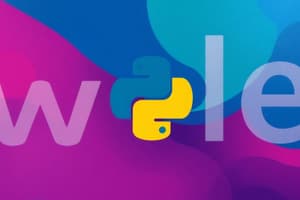Podcast
Questions and Answers
What is the purpose of a for loop in Python?
What is the purpose of a for loop in Python?
To iterate over a sequence (such as a list, tuple, or string) and execute a block of code for each item.
What is the purpose of the break statement in a loop?
What is the purpose of the break statement in a loop?
To exit the loop prematurely.
How do you iterate over the key-value pairs of a dictionary in Python?
How do you iterate over the key-value pairs of a dictionary in Python?
Using the items() method, for example: for key, value in dict.items():
What is the purpose of a nested loop?
What is the purpose of a nested loop?
What is the difference between the continue and break statements?
What is the difference between the continue and break statements?
How do you iterate over a string in Python?
How do you iterate over a string in Python?
What is the purpose of the pass statement in a loop?
What is the purpose of the pass statement in a loop?
Flashcards are hidden until you start studying
Study Notes
For Loops
- Used to iterate over a sequence (such as a list, tuple, or string) and execute a block of code for each item
- Syntax:
for variable in iterable: - Example:
fruits = ['apple', 'banana', 'cherry']; for fruit in fruits: print(fruit)
Loop Control Statements
break: exits the loop prematurely- Example:
for i in range(5): if i == 3: break; print(i)
- Example:
continue: skips the current iteration and moves to the next one- Example:
for i in range(5): if i == 3: continue; print(i)
- Example:
pass: does nothing, used as a placeholder when a statement is required syntactically- Example:
for i in range(5): if i == 3: pass; print(i)
- Example:
Nested Loops
- A loop inside another loop
- Used to iterate over multiple sequences or perform complex iterations
- Example:
for i in range(3):
for j in range(3):
print(f"i: {i}, j: {j}")
Iterating Over Data Structures
- Lists:
for item in list: - Tuples:
for item in tuple: - Strings:
for char in string: - Dictionaries:
for key in dict:iterates over keysfor value in dict.values():iterates over valuesfor key, value in dict.items():iterates over key-value pairs
- Sets:
for item in set:
For Loops
- Used to iterate over sequences like lists, tuples, or strings, executing a block of code for each item
- Syntax is
for variable in iterable:
Loop Control Statements
Break Statement
- Exits the loop prematurely
- Example: use
breakto stop a loop when a condition is met (e.g.,for i in range(5): if i == 3: break; print(i))
Continue Statement
- Skips the current iteration and moves to the next one
- Example: use
continueto skip an iteration when a condition is met (e.g.,for i in range(5): if i == 3: continue; print(i))
Pass Statement
- Does nothing and is used as a placeholder when a statement is required syntactically
- Example: use
passwhen a statement is needed, but no action is required (e.g.,for i in range(5): if i == 3: pass; print(i))
Nested Loops
- A loop inside another loop
- Used to iterate over multiple sequences or perform complex iterations
- Example: iterating over multiple ranges (e.g.,
for i in range(3): for j in range(3): print(f"i: {i}, j: {j}"))
Iterating Over Data Structures
Lists
- Iterate over list items using
for item in list:
Tuples
- Iterate over tuple items using
for item in tuple:
Strings
- Iterate over characters in a string using
for char in string:
Dictionaries
- Iterate over dictionary keys using
for key in dict: - Iterate over dictionary values using
for value in dict.values(): - Iterate over key-value pairs using
for key, value in dict.items():
Sets
- Iterate over set items using
for item in set:
Studying That Suits You
Use AI to generate personalized quizzes and flashcards to suit your learning preferences.




